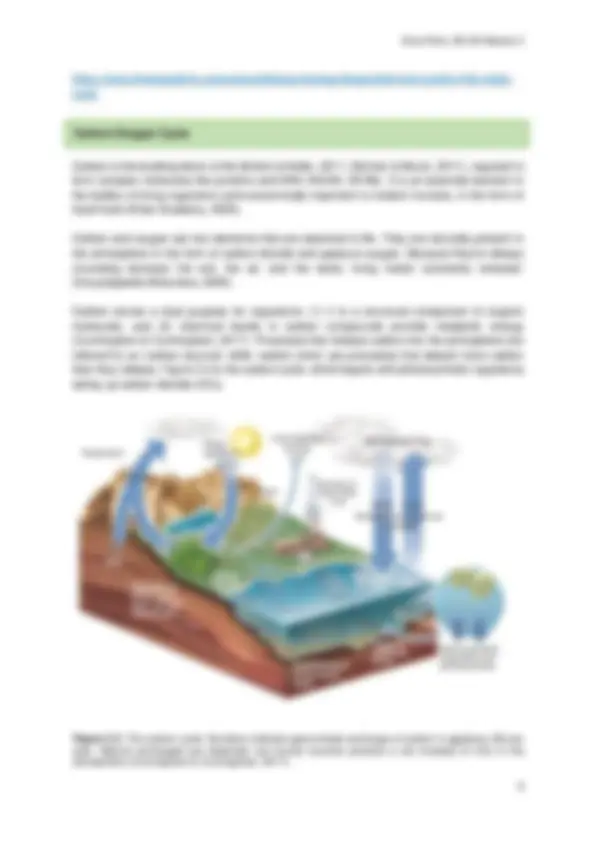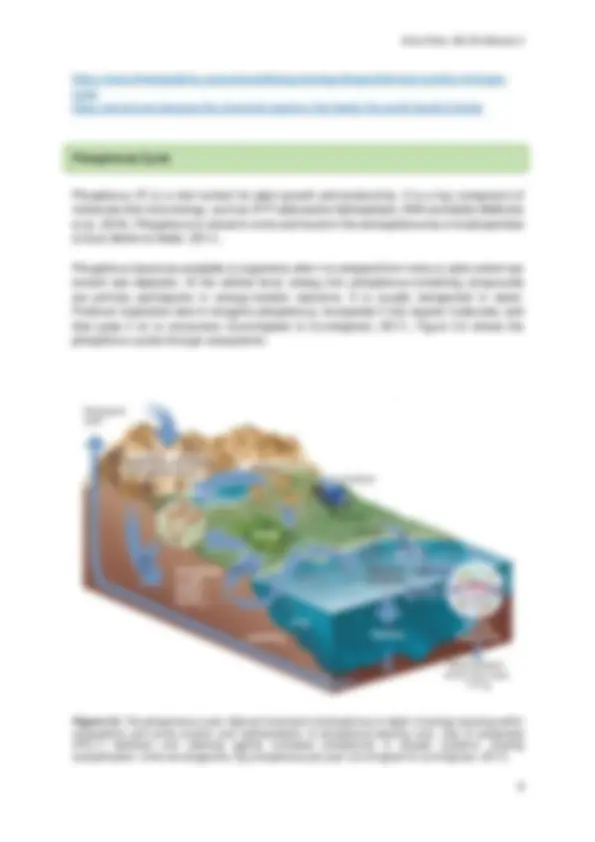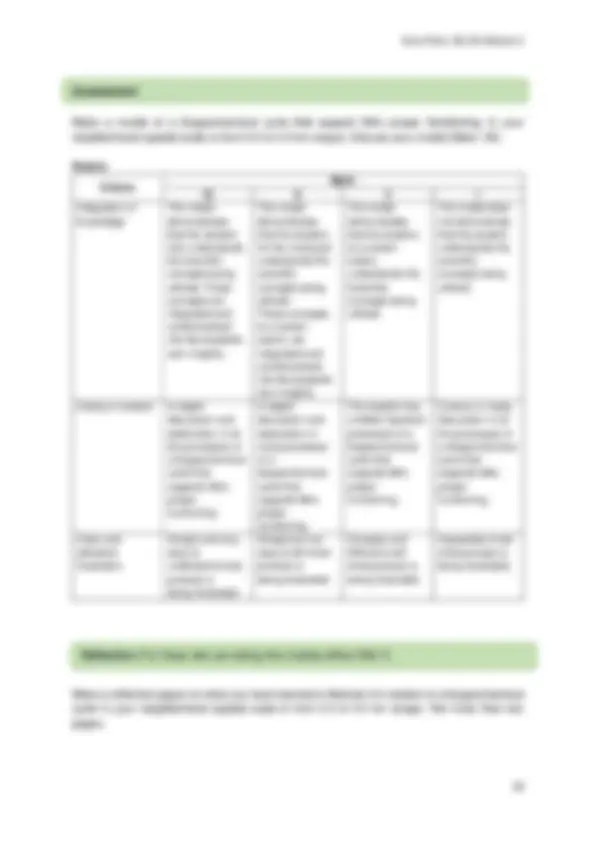








Study with the several resources on Docsity

Earn points by helping other students or get them with a premium plan


Prepare for your exams
Study with the several resources on Docsity

Earn points to download
Earn points by helping other students or get them with a premium plan
Community
Ask the community for help and clear up your study doubts
Discover the best universities in your country according to Docsity users
Free resources
Download our free guides on studying techniques, anxiety management strategies, and thesis advice from Docsity tutors
This document help you to learn more about science
Typology: Cheat Sheet
1 / 11

This page cannot be seen from the preview
Don't miss anything!







GE-ES Environmental Science (First Semester, AY 2020-2021) Module 3 : Relating the Importance of Biogeochemical Cycles for Life’s Proper Functioning Course Outcome Learners who can model the components of the natural world and their interactions. Making Connections: In Module 2, you have learned about the biosphere and its functional unit, the ecosystems. Overview In this module, you will learn about the chemical elements that are essential to life. These include water, carbon, nitrogen, and phosphorus. The study of this module will take you around 3 hours, however, you may do it at your own pace. Where there are suggested internet links, please visit the site and read. Learning Outcomes After completing the study of this module, you should be able to:
Learning Enrichment 3 .1: To enrich your knowledge on the chemical and biological foundations of life, read Mutiti et al. (2018), pp. 2-6. NOTE: For those who are taking this course offline, be sure to download a copy of this book from the course materials under Week 5. Lesson Proper This term ‘biogeochemical cycle’ refers to any of the natural pathways by which chemicals move through the biosphere and other Earth’s major systems (Figure 3.1). It is important for life’s proper functioning. Similarly, the study of this chemical cycle is important in solving many environmental problems (Botkin & Keller, 2011). The human mobilization of carbon, nitrogen, and phosphorus from the Earth’s crust and atmosphere into the environment has increased 36, 9, and 13 times, respectively, compared to geological sources over pre-industrial times (Schlesinger & Bernhardt, 2013 as cited by Galloway et al., 2014). Figure 3 .1. Idealized diagram of the geologic cycle, which includes the tectonic, hydrologic, rock, and biogeochemical cycles (Botkin & Keller, 2011). Biogeochemical Cycles
Figure 3. 2. The water cycle (NOAA, 2019). The area or space where water is present as it cycles on Earth is referred to as the hydrosphere. Learning Check 3. 2 : Fill out the table below with the water sources and uses in your neighborhood (spatial scale is from 0.5 to 4.0 km range). Note: Maximum of three sources and include as many uses as you have observed. Table 3. 2. Water sources and uses in your neighborhood. Source Use(s)
Learning Enrichment 3. 3 : To enrich your knowledge about the water or hydrologic cycle, read the following references: Botkin & Keller (2011), pp. 115 - 116 Cunningham & Cunningham (2017), pp. 41- 42 Mutiti et al. (2018), pp. 10- 20 Skinner & Murck (2011), pp. 223- 253 NOTE: For those who are taking this course offline, read the references mentioned above. Be sure to download these books from the course materials under Week 5. Also, watch this video (optional for those who are taking this course offline):
https://www.khanacademy.org/science/biology/ecology/biogeochemical-cycles/v/the-water- cycle Carbon is the building block of life (Botkin & Keller, 2011; Skinner & Murck, 2011), required to form complex molecules like proteins and DNA (NOAA, 201 9 b). It is an essential element in the bodies of living organisms and economically important to modern humans, in the form of fossil fuels (Khan Academy, 2020). Carbon and oxygen are two elements that are essential to life. They are naturally present in the atmosphere in the form of carbon dioxide and gaseous oxygen. Because they're always circulating between the soil, the air, and the water, living matter constantly renewed. (Encyclopædia Britannica, 2020). Carbon serves a dual purpose for organisms: (1) it is a structural component of organic molecules, and (2) chemical bonds in carbon compounds provide metabolic energy (Cunningham & Cunningham, 2017). Processes that release carbon into the atmosphere are referred to as ‘carbon sources’ while ‘carbon sinks’ are processes that absorb more carbon than they release. Figure 3.3 is the carbon cycle, which begins with photosynthetic organisms taking up carbon dioxide (CO 2 ). Figure 3.3. The carbon cycle. Numbers indicate approximate exchange of carbon in gigatons (Gt) per year. Natural exchanges are balanced, but human sources produce a net increase of CO 2 in the atmosphere (Cunningham & Cunningham, 2017). Carbon-Oxygen Cycle
Figure 3. 4. The global nitrogen cycle. Numbers in boxes indicate amounts stored, and numbers with arrows indicate annual flux, in millions of metric tons of nitrogen (Botkin & Keller, 2011). In natural ecosystems, nitrogen is often the limiting nutrient. When a nutrient is limiting, adding more of it will increase growth, e.g., it will cause plants to grow taller than if nothing were added (Khan Academy, 2020). Learning Check 3.4: The use of nitrogen (chemical) fertilizers, which have increased agricultural production over the past 50 years, has dramatically altered the nitrogen cycle (Galloway et al., 2014). Can you think of ways we could reduce the amount of nitrogen we put into our environment?
Learning Enrichment 3.5: To enrich your knowledge about the nitrogen cycle, read the following references: Botkin & Keller (2011), pp. 120- 121 Cunningham & Cunningham (2017), p. 49 Galloway et al. (2014), pp. 352 - 355 Leghari et al. (2016), 209- 216 Skinner & Murck (2011), pp. 46 5 - 467 Also, watch these videos (optional for those who are taking this course offline):
https://www.khanacademy.org/science/biology/ecology/biogeochemical-cycles/v/nitrogen- cycle https://ed.ted.com/lessons/the-chemical-reaction-that-feeds-the-world-daniel-d-dulek Phosphorus (P) is a vital nutrient for plant growth and productivity. It is a key component of molecules that store energy, such as ATP (adenosine triphosphate), DNA and lipids (Malhotra et al., 2018). Phosphorus is stored in rocks and found in the atmosphere only in small particles of dust (Botkin & Keller, 2011). Phosphorus becomes available to organisms after it is released from rocks or salts (which are ancient sea deposits). At the cellular level, energy-rich, phosphorus-containing compounds are primary participants in energy-transfer reactions. It is usually transported in water. Producer organisms take in inorganic phosphorus, incorporate it into organic molecules, and then pass it on to consumers (Cunningham & Cunningham, 2017). Figure 3. 5 shows the phosphorus cycles through ecosystems. Figure 3. 5. The phosphorus cycle. Natural movement of phosphorus is slight, involving recycling within ecosystems and some erosion and sedimentation of phosphorus-bearing rock. Use of phosphate (PO 4 −^3 ) fertilizers and cleaning agents increases phosphorus in aquatic systems, causing eutrophication. Units are teragrams (Tg) phosphorus per year (Cunningham & Cunningham, 2017). Phosphorus Cycle
Assessment: Make a model of a biogeochemical cycle that support life’s proper functioning in your neighborhood (spatial scale is from 0.5 to 4.0 km range). Discuss your model (Mark: 30). Rubric Criteria Mark 10 6 3 1 Integration of knowledge The model demonstrates that the student fully understands the scientific concepts being utilized. These concepts are integrated and contextualized into the student’s own insights. The model demonstrates that the student, for the most part, understands the scientific concepts being utilized. These concepts, to a certain extent, are integrated and contextualized into the student’s own insights. The model demonstrates that the student, to a certain extent, understands the Scientific concepts being utilized. The model does not demonstrate that the student understands the scientific concepts being utilized. Clarity of content In-depth discussion and elaboration in all the processes of a biogeochemical cycle that supports life’s proper functioning. In-depth discussion and elaboration in most processes of a biogeochemical cycle that supports life’s proper functioning. The student has omitted important processes of a biogeochemical cycle that supports life’s proper functioning. Cursory or hasty discussion in all the processes of a biogeochemical cycle that supports life’s proper functioning. Clear and attractive illustration Simple and very easy to understand what process is being illustrated. Simple but not easy to tell what process is being illustrated. Complex and difficult to tell what process is being illustrated. Impossible to tell what process is being illustrated. Reflection Make a reflection paper on what you have learned in Module 3 in relation to a biogeochemical cycle in your neighborhood (spatial scale is from 0.5 to 4.0 km range). Not more than two pages. Assessment Reflection (For those who are taking this module offline ONLY)
Books and Other Published Materials: Botkin, D. B., & Keller, E. A. (2011). ENVIRONMENTAL SCIENCE: Earth as a Living Planet, Eighth Edition. John Wiley & Sons, Inc., USA. https://doi.org/10.2134/jeq1995.00472425002400050040x Cunningham, W., & Cunningham, M. A. (2017). Principles of ENVIRONMENTAL SCIENCE: Inquiry & Application, Eighth Edition. McGraw-Hill Education, New York, USA. Galloway, J. N., Schlesinger, W. H., Clark, C. M., Grimm, N. B., Jackson, R. B., Law, B. E., Thornton, P. E., Townsend, A. R., & Martin, R. (2014). Biogeochemical Cycles. Climate Change Impacts in the United States: The Third National Climate Assessment. In G. W. Melillo, J. M., Richmond, T., & Yohe (Ed.), U.S. Global Change Research Program (pp. 350 – 368). https://doi.org/10.7930/J0X63JT Leghari, S. J., Wahocho, N. A., Laghari, G. M., HafeezLaghari, A., MustafaBhabhan, G., HussainTalpur, K., & Lashari, A. A. (2016). Role of nitrogen for plant growth and development : A review. Advances in Environmental Biology , 10 (9), 209–219. Malhotra, H., Vandana, Sharma, S., & Pandey, R. (2018). Phosphorus Nutrition: Plant Growth in Response to Deficiency and Excess. In Hasanuzzaman (Ed.), Plant Nutrients and Abiotic Stress Tolerance (pp. 171–190). Springer Nature Singapore Pte Ltd. https://doi.org/10.1007/978- 981 - 10 - 9044 - 8_ Mutiti, S., Mutiti, C., Manoylov, K., Vandevoort, A., & Bennett, D. (2018). Introduction to Environmental Science, 3rd Edition. Open Textbook, Georgia College and State University, USA. Skinner, B. J., & Murck, B. W. (2011). The Blue Planet: An Introduction to Earth System Science, 3rd Edition. John Wiley & Sons, Inc., USA. Internet Links: Encyclopædia Britannica. (2020). Understand the carbon and oxygen cycles in the atmosphere. https://www.britannica.com/video/143200/organisms-carbon-cycling- oxygen-environment. Khan Academy. (2020). Intro to biogeochemical cycle. https://www.khanacademy.org/science/biology/ecology/biogeochemical- cycles/a/introduction-to-biogeochemical-cycles. National Oceanic and Atmospheric Administration, NOAA. (2019a). Water cycle. https://www.noaa.gov/education/resource-collections/freshwater/water-cycle. National Oceanic and Atmospheric Administration, NOAA. (2019b). What is the carbon cycle? National Ocean Service website. https://oceanservice.noaa.gov/facts/carbon- cycle.html. ANSWER KEY ( NOTE: Model answers in Module 3 shall be provided after you have completed and submitted all the requirements under this module. It will be sent through your individual email.)